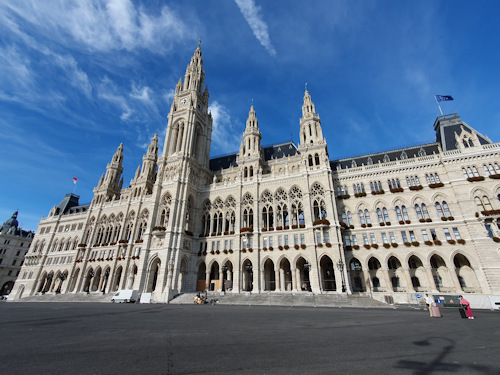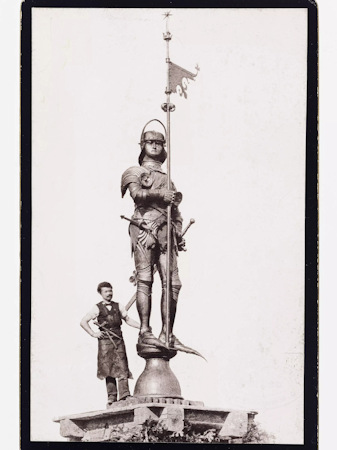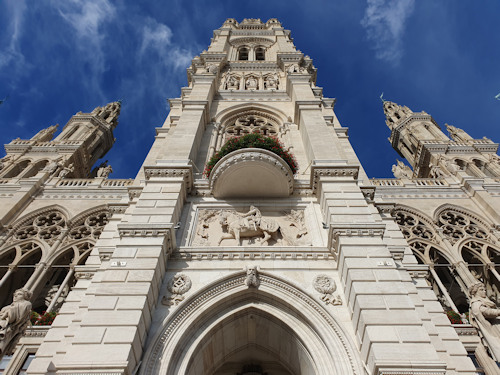
One of the tallest and most impressive buildings in central Vienna is the Rathaus. The towers look down majestically onto a central square and park alongside Vienna’s mighty Ringstrassen boulevard.
- 19th-century neo-Gothic design
- Administrative headquarters of the city
- Sneakily taller than it should be
- Looks particularly good on photos
- Choose & book a guided tour* of Vienna
- See also:
City hall

(The Rathaus on a remarkably quiet day)
All those who meet German for the first time enjoy the thought of government offices being called rat houses. For the record, Rat means “advice,” “counsel” or indeed “council,” while the German for rat is Ratte.
Vienna’s Rathaus is the seat of the provincial and city government (Vienna is both a city and a province), housing hundreds of officials and notable institutions like the city library.
The building has over 1500 rooms and more than 2000 windows, which can be tough on the cleaning budget. Its long façade often finds excellent use as a sight in its own right, for example as host for art installations.

(A view at Christmas through the entrance arch of the Christkindlmarkt)
The Rathausplatz square in front of the building is, perhaps, more important to the visitor than the Rathaus itself. The open area hosts various events throughout the year. This is where you find Vienna’s Christkindlmarkt Christmas market, for example, or the Vienna Eistraum open-air ice skating.
The history
The building opened in 1883 as part of the huge swathe of construction that followed the removal of the old city’s fortifications (other contemporary projects included the giant boulevard that marks one end of the Rathausplatz).
The last stone fell into place on September 12th, coinciding with the 200th anniversary of the end of the siege of Vienna.
Friedrich Schmidt (a resident architect at St. Stephen’s Cathedral) came up with the design. Reflecting the historicism prevalent at the time, Schmidt used a neo-Gothic approach that makes everything look older than it is.

(Photograph of the Rathaus by an unknown photographer during construction around 1879; Wien Museum Inv.-Nr. 29013/1; reproduced with permission under the terms of the CC0 licence)
Opposite the Rathaus, on the other side of the Ring, is Vienna’s Burgtheater state theatre. To see the live view from the Burgtheater, take a peek at this webcam. Assuming there’s enough light, you’ll find the Rathausplatz in the foreground with the Rathaus behind.
The Rathausmann
Schmidt was a decent architect, but also a cunning one. Consider the story of the Rathausmann, the name given to the armoured knight at the top of the Rathaus’s central tower.
Our friendly knight holds a long pole bearing the city flag. Without the statue, the Rathaus tower reaches just under 98m. With it, 103.3m.
So what?
Well, let’s first go back to 1854.

The Rathausmann before installation and next to the metalworker who made it (Alexander Nehr), photographed by Josef Löwy around 1882; Wien Museum Inv.-Nr. 94680/23; excerpt reproduced with permission under the terms of the CC0 licence)
Emperor Franz Joseph was sampling some fresh air with one of his adjutants when a tailor named János Libényi tried to kill him, apparently as revenge for the executions that followed Hungary’s failed 1848 revolution. (A fate then shared by Libényi himself after wounding the Emperor.)
In an act of gratitude for Franz Joseph’s survival, thousands of generous subjects donated money to build the Votivkirche, a church completed in 1879 and located some 400m north of the Rathaus.
Allegedly, the Emperor decreed that no new secular building should exceed the height of this church, whose tallest towers reach 99m.
Which is why Schmidt capped the Rathaus tower at around 98m (good lad). And then popped the statue on top to get round the restriction (cheeky).

(View up the central tower)
With this little trick, Schmidt ensured “his” Rathaus became Vienna’s second-tallest building after Stephansdom cathedral.
(Incidentally, you can get up close and personal with the Rathausmann on a Future Bus tour: the Rathaus is one of the virtual reality experiences during the tour.)
How to get to the Rathaus
To be honest, you’ll probably pass the building anyway as you walk around the city centre. You can get great photos now as the façade completed a 10+ year cleaning and renovation process in late 2023.
And, if you need sustenance on that walk, one of my favourite café-patisseries lives nearby: Conditorei Sluka.
Subway: The Rathaus has its own subway station on the opposite side to the park. Take the U2 line to the Rathaus station.
Tram/bus: the 1, D and 71 trams drop by the Rathausplatz/Burgtheater stop outside the Rathausplatz square. And the 2 calls in at the Rathaus stop.
Address: Friedrich-Schmidt-Platz 1, 1010 Vienna